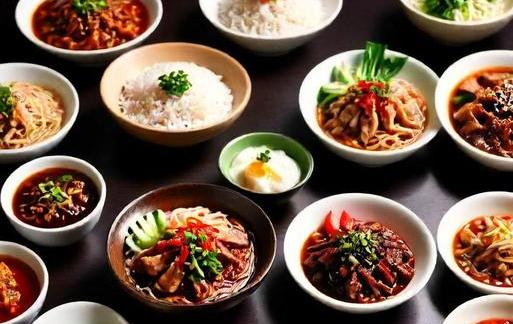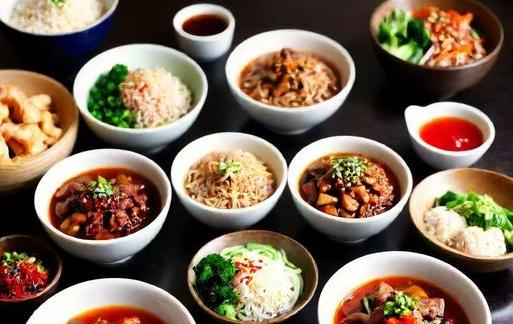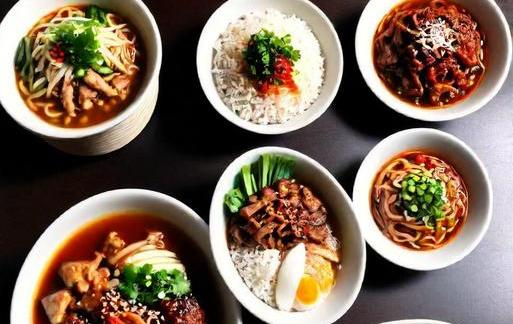- You are here:
- Home »
- Food
- » [REVEALED] Asian Foods That Start With Z
[REVEALED] Asian Foods That Start With Z
Note: This page contains affiliate links.
As an Amazon Associate, I earn from qualifying purchases when you click on the link, but you are not charged extra.
Asian cuisine is a vast and diverse tapestry of flavors, textures, and aromas that have captivated food enthusiasts worldwide. Exploring the culinary wonders of Asia unveils a rich assortment of dishes, each contributing to the cultural mosaic of the continent. In this gastronomic journey, we focus on the less-explored realm of Asian foods that start with the letter ‘Z’. From savory delicacies to mouthwatering desserts, the list is an intriguing exploration of unique flavors and culinary traditions.
Contents
List Of Asian Foods That Start With Z

1. Zongzi (粽子)
Description: Zongzi is a traditional Chinese dish that consists of glutinous rice stuffed with various ingredients such as meats, beans, and nuts, wrapped in bamboo leaves and then steamed or boiled. These pyramid-shaped parcels are often associated with the Dragon Boat Festival, where they symbolize protection against evil spirits.
Preparation: The preparation of Zongzi is a meticulous process. The sticky rice is soaked and layered with different fillings, creating a harmonious blend of flavors. The bamboo leaves provide a distinct aroma while steaming enhances the overall taste.
2. Zaru Soba (ざるそば)
Description: Zaru Soba is a Japanese dish comprising cold buckwheat noodles served on a bamboo sieve-like tray called a "zaru." The noodles are accompanied by a dipping sauce known as "tsuyu," which is made from soy sauce, mirin, and dashi. Zaru Soba is a popular choice, especially during the hot summer months.
Preparation: The soba noodles are boiled, cooled, and arranged on the zaru. The tsuyu, often garnished with grated daikon radish and green onions, adds a refreshing and savory element to the dish.
3. Zha Jiang Mian (炸酱面)
Description: Originating from China, Zha Jiang Mian is a savory noodle dish featuring thick wheat noodles topped with a rich, flavorful sauce made from ground meat (usually pork or beef), fermented soybean paste, and various seasonings. It is commonly garnished with fresh vegetables like cucumber and bean sprouts.
Preparation: The sauce is the heart of Zha Jiang Mian. The meat is stir-fried until browned, and the fermented soybean paste is added, creating a luscious and umami-packed topping for the noodles.
4. Zhajiang Bao (炸酱包)
Description: Zhajiang Bao, also known as "Fried Sauce Buns," is a popular street food in China. These steamed buns are filled with a mixture of ground pork or beef cooked in a savory and slightly sweet fermented soybean paste sauce. The combination of soft bun and flavorful filling makes it a delightful treat.
Preparation: The dough for the bao is made with flour, yeast, and water, then filled with the cooked zhajiang mixture. The buns are steamed until fluffy, creating a perfect balance between the tender exterior and savory interior.
5. Zerde (زرده)
Description: Zerde is a traditional Turkish dessert, a sweet rice pudding delicately flavored with saffron. The dish has a vibrant yellow color and a distinctive aroma, making it a favorite during festive occasions and celebrations in Turkish culture.
Preparation: The key to Zerde’s unique color and flavor is saffron. The rice is cooked with sugar, water, and saffron until it reaches a creamy consistency. It is then garnished with nuts and dried fruits.
6. Zhingalov Hats (Ժինգալով Հաց)
Description: Hailing from Armenia, Zhingalov Hats is a flatbread stuffed with a variety of fresh herbs such as parsley, cilantro, and scallions. The dough is thin and unleavened, allowing the vibrant flavors of the herbs to shine through. It is a popular street food, cherished for its simplicity and taste.
Preparation: The dough is rolled out thinly and filled with a generous amount of finely chopped herbs. The bread is then baked on a griddle until it develops a golden-brown crust, resulting in a fragrant and flavorful snack.
7. Zong (ဇော်ပင်လင်း)
Description: Zong, a traditional Burmese food, is a type of pancake made from glutinous rice flour and coconut milk. It is often served with jaggery syrup, adding sweetness to the delightful chewiness of the pancake. Zong is a popular choice for breakfast or as a snack in Myanmar.
Preparation: The batter for Zong is made by combining glutinous rice flour and coconut milk, creating a smooth and creamy mixture. The pancakes are then cooked on a griddle until they achieve a tender consistency.
8. Zin Ghe Le (ဇင်ခဲလဲ)
Description: Zin Ghe Le is a traditional Burmese dish that features vermicelli noodles served with a rich and aromatic coconut milk broth. The broth is infused with a variety of spices, giving the dish a complex and satisfying flavor profile. Zin Ghe Le is often garnished with crispy fried onions and fresh herbs.
Preparation: The broth is the soul of Zin Ghe Le. Coconut milk is combined with spices such as turmeric, ginger, and lemongrass, creating a fragrant and flavorful base. The vermicelli noodles are then cooked in the broth until tender.
The diverse and flavorful world of Asian cuisine never ceases to amaze, and exploring foods that start with ‘Z’ provides a unique glimpse into lesser-known culinary treasures. From the intricate preparation of Zongzi in China to the refreshing simplicity of Zaru Soba in Japan, each dish carries a story of tradition, culture, and culinary artistry. Whether you’re a seasoned food enthusiast or a curious newcomer, these Asian foods that start with ‘Z’ invite you on a delectable journey across the continent, savoring the richness of flavors and the beauty of culinary diversity.
Significance

Asian cuisine is renowned for its rich and diverse flavors, encompassing a vast array of ingredients and cooking techniques. In this exploration, we delve into the lesser-known realm of Asian foods that start with the letter Z. While not as common as some other letters in the alphabet, the culinary landscape surprises us with unique and delectable offerings.
The significance of exploring Asian foods starting with the letter Z lies in uncovering the hidden gems that might not be widely recognized on a global scale. As we delve into these culinary delights, we gain a deeper understanding of the local traditions, ingredients, and cooking methods that shape the distinctive flavors of Asian cuisine.
Category-Related

1. Zongzi – A Culinary Tradition Wrapped In Bamboo Leaves
Description: Zongzi is a traditional Chinese dish, typically enjoyed during the Dragon Boat Festival. These pyramid-shaped parcels consist of glutinous rice filled with a variety of ingredients such as meats, beans, and nuts, all wrapped in bamboo leaves and steamed to perfection.
Ingredients:
- Glutinous rice
- Pork or other meats
- Mung beans
- Salted duck egg yolk
- Dried shiitake mushrooms
- Bamboo leaves
Cooking Method:
Zongzi is a labor-intensive dish. The glutinous rice is soaked and filled with the chosen ingredients. The mixture is then wrapped securely in bamboo leaves, forming a triangular or pyramidal shape. The parcels are then steamed or boiled for several hours, allowing the flavors to meld and the rice to become tender.
Cultural Significance:
Zongzi holds cultural significance, especially during the Dragon Boat Festival, where families gather to prepare and share these delectable parcels. The dish is believed to commemorate Qu Yuan, a poet and statesman from ancient China.
2. Zaru Soba – Japanese Cold Buckwheat Noodles
Description:
Zaru Soba is a popular Japanese dish that features cold buckwheat noodles served on a bamboo mat (zaru). The noodles are accompanied by a dipping sauce called tsuyu, made from soy sauce, mirin, and dashi. Toppings like nori (seaweed), green onions, and wasabi are often added to enhance the flavor.
Ingredients:
- Buckwheat noodles
- Tsuyu (soy sauce, mirin, dashi)
- Nori (seaweed)
- Green onions
- Wasabi
Preparation:
The buckwheat noodles are boiled, rinsed in cold water, and then placed on the bamboo mat. The tsuyu dipping sauce is served alongside, and diners can customize their experience by adding condiments like nori, green onions, and wasabi.
Culinary Experience:
Zaru Soba is a refreshing and light dish, perfect for hot summer days. The cold noodles paired with the umami-rich dipping sauce create a harmonious balance of flavors, making it a favorite among Japanese noodle enthusiasts.
Common Themes
Umami – The Fifth Taste In Asian Cuisine
One common theme that transcends various Asian foods is the presence of umami. Known as the fifth taste, umami is often described as savory, brothy, or meaty. Many Asian dishes achieve this flavor profile through the use of ingredients like soy sauce, miso, fish sauce, and seaweed. Whether it’s a steaming bowl of ramen or a plate of sushi, umami plays a pivotal role in elevating the taste experience in Asian cuisine.
Rice – The Staple Grain
Rice stands as the cornerstone of many Asian cuisines. From Chinese fried rice to Japanese sushi rice, this versatile grain takes center stage in a myriad of dishes. Its importance goes beyond mere sustenance, representing cultural symbolism and tradition. The meticulous cultivation and preparation of rice showcase the dedication to craftsmanship that characterizes Asian culinary practices.
Interesting Facts
Zongzi’s Symbolic Shapes
Zongzi’s pyramid or triangular shape is not just an aesthetic choice; it holds symbolic meaning. The shape is believed to originate from ancient Chinese customs of offering triangular-shaped food to deities during religious ceremonies. The meticulous folding and tying of bamboo leaves not only contribute to the dish’s appearance but also play a role in preserving and infusing flavors during the cooking process.
Zaru Soba’s Cultural Connection
Zaru Soba is not just a delightful dish; it also has cultural significance in Japan. Consumed on New Year’s Eve in a tradition known as Toshikoshi Soba, the dish is believed to symbolize the crossing from one year to the next. The long, uncut soba noodles represent longevity and are often eaten to wish for a long and prosperous life.
Conclusion
In this gastronomic journey through Asian foods that start with Z, we’ve uncovered the depth and variety that characterize this continent’s culinary landscape. From the labor-intensive preparation of Zongzi to the refreshing simplicity of Zaru Soba, each dish tells a unique story rooted in tradition, symbolism, and local flavors. As we continue to explore the lesser-known corners of Asian cuisine, we gain not only a taste of diverse and delectable dishes but also a deeper appreciation for the cultural richness that binds these culinary traditions together. So, the next time you find yourself on a culinary adventure, consider trying one of these Asian delights that start with the letter Z, and savor the flavors that echo centuries of tradition and craftsmanship.


